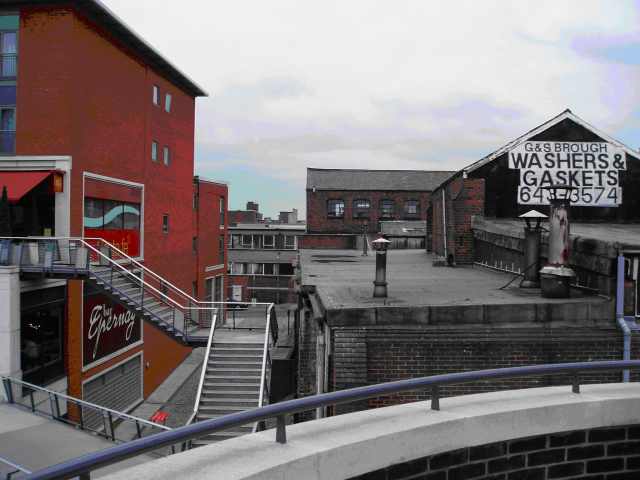Deindustialisation - Sample Answer
Unit G2 – Human Geography – Urban Settlement
Figure 1. Different land uses within the CBD of Birmingham

Source: KDG Photos
a) Use information in Figure 1 to explain how the changing global economy can lead to changes in the central areas of cities in MEDCs.
[5]
There are many reasons why there are changes occurring in central areas of cities in MEDCs. LEDCs such as China and India have taken advantage of their cheap labour and lower costs of production and have spurred their rapid economic growth by the development of their manufacturing industries. This movement of production to the Far East has meant deindustrialisation of manufacturing industries in the UK as more people become employed in services and less people are employed in manufacturing.
Deindustrialisation is evident in Figure 1 as the ‘washers’ and ‘gasketts’ warehouse appears derelict and unused compared to the modern successful bar or restaurant next door to it (Bar Epernay).
Figure 1 also shows regeneration in inner city areas of an MEDC as it is likely the modern restaurant was converted or/rebuilt from a derelict warehouse similar to the one next door (a brownfield site).
Changes in the global economy have caused inner city decline represented by the old warehouse.
Excellent response – has referred to Figure 1. Has also explained the global shift in manufacturing.
---------------------------------------------------------------------------------------------------------------------------------------------------
b) Outline the reasons for counter-urbanisation in MEDC cities.
[10]
Counter-urbanisation is the process by which people move out of urban areas to live in rural areas.
There are many reasons why people wish to leave urban areas, known as push factors. Firstly, there are high levels of atmospheric and noise pollution in urban areas due to heavy congestion, this can also often mean commuting times to work are long even though the actual proximity to a work place is short. Secondly, homes in urban areas are often smaller due to the lack of space, they also often have limited outdoor space like gardens (as can be seen in inner city terraced housing or tower blocks).
There are many pull factors that attract people to the countryside. The homes are often larger and have more open space. Rural settlements are often very aesthetically pleasing and ‘greener’ places to live. Being in a rural area also can mean there is easier access to major transport links such as motorways and airports – for example the construction of the M42 and M40 has opened up many areas south of Birmingham towards the Cotswolds.
The process of filtering is also a reason for counter-urbanisation as families gain wealth they move to larger homes in idyllic, rural settings.
An example of counter-urbanisation could be people from inner city areas such as Shirley or Yardley with the Birmingham conurbation out to commuter villages such as Henley-in-Arden. Henley-in-Arden is a popular commuter village that attracts families as it has easy access to the M42 motorway and is within close proximity to BirminghamAirport and the city centre.
The Exam Board Mark Scheme wants a clear definition for counter-urbanisation, good. Push pull factors explained. Appropriate used of named case studies. A good example of a Level 3 response.
How your marks are awarded
Level 3 response:8-10 marks
Level 2 response:4-7 marks
Level 1 response:0-3 marks
--------------------------------------------------------------------------------------------------------------------------
c) Why is the regeneration of central areas often considered appropriate in urban areas of MEDC cities?
[10]
Regeneration of inner city areas is appropriate in the cities of MEDCs to overcome inner city decline, deprivation and decentralisation of entertainment, retailing and industry. Regeneration of inner city areas is also important to maintain investment in a city and attract the attention of firms and corporations that bring wealth and affluence to urban areas.
When the Round Oak Steelworks in Dudley closed in the 1980s, upon its derelict site the Merry Hill Shopping Centre was constructed. This was a successful development especially because it was regeneration of the brownfield site which saves construction on greenfield sites or Green Belt land.
However, Merry Hill caused the decentralisation of retailing from Birmingham’s city centre. This lead to the Zone of Assimilation development on the east side of Birmingham’s CBD; this £500 million project included the creation of Brindley Place which comprised high-class accommodation, restaurants and bars. The Mailbox was converted into offices and expensive restaurants and bars. The old Bull Ring was also redeveloped to attract retailers back to the city centre.
Regeneration of inner city centres is necessary as it creates vibrancy in a city and is developing brownfield sites. This helps to conserve the biodiversity, maintain foodchains and habitats on greenfield sites. Regeneration within urban areas also helps to reduce urban sprawl and building on the greenbelt.
The Exam Board Mark Scheme defines ‘central areas’ as any area that has a central location this could include the CBD, the Zone in Transition or the inner city tower blocks and terraced housing. This answer used the CBD of Birmingham – but an equally good response could have been made using – The Star City Project, or the creation of an Urban Village, as seen in the traditional, terraced community along the Ladypool Road – Sparkbrook.
This is a Level 3 response (8-10 marks) due to the sound human geography theory and the excellent use of case studies, names and details.
How your marks are awarded
Level 3 response: 8-10 marks
Level 2 response: 4-7 marks
Level 1 response: 0-3 marks
|